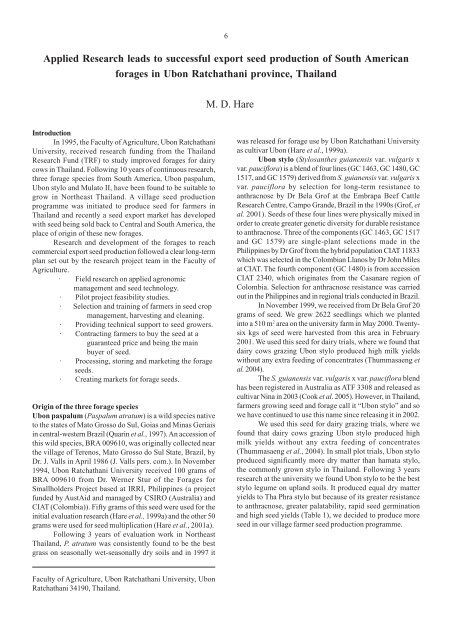6th IHSG Conference - International Herbage Seed Group
6th IHSG Conference - International Herbage Seed Group
6th IHSG Conference - International Herbage Seed Group
- No tags were found...
Create successful ePaper yourself
Turn your PDF publications into a flip-book with our unique Google optimized e-Paper software.
6Applied Research leads to successful export seed production of South Americanforages in Ubon Ratchathani province, ThailandM. D. HareIntroductionIn 1995, the Faculty of Agriculture, Ubon RatchathaniUniversity, received research funding from the ThailandResearch Fund (TRF) to study improved forages for dairycows in Thailand. Following 10 years of continuous research,three forage species from South America, Ubon paspalum,Ubon stylo and Mulato II, have been found to be suitable togrow in Northeast Thailand. A village seed productionprogramme was initiated to produce seed for farmers inThailand and recently a seed export market has developedwith seed being sold back to Central and South America, theplace of origin of these new forages.Research and development of the forages to reachcommercial export seed production followed a clear long-termplan set out by the research project team in the Faculty ofAgriculture.· Field research on applied agronomicmanagement and seed technology.· Pilot project feasibility studies.· Selection and training of farmers in seed cropmanagement, harvesting and cleaning.· Providing technical support to seed growers.· Contracting farmers to buy the seed at aguaranteed price and being the mainbuyer of seed.· Processing, storing and marketing the forageseeds.· Creating markets for forage seeds.Origin of the three forage speciesUbon paspalum (Paspalum atratum) is a wild species nativeto the states of Mato Grosso do Sul, Goias and Minas Geriaisin central-western Brazil (Quarin et al., 1997). An accession ofthis wild species, BRA 009610, was originally collected nearthe village of Terenos, Mato Grosso do Sul State, Brazil, byDr. J. Valls in April 1986 (J. Valls pers. com.). In November1994, Ubon Ratchathani University received 100 grams ofBRA 009610 from Dr. Werner Stur of the Forages forSmallholders Project based at IRRI, Philippines (a projectfunded by AustAid and managed by CSIRO (Australia) andCIAT (Colombia)). Fifty grams of this seed were used for theinitial evaluation research (Hare et al., 1999a) and the other 50grams were used for seed multiplication (Hare et al., 2001a).Following 3 years of evaluation work in NortheastThailand, P. atratum was consistently found to be the bestgrass on seasonally wet-seasonally dry soils and in 1997 itwas released for forage use by Ubon Ratchathani Universityas cultivar Ubon (Hare et al., 1999a).Ubon stylo (Stylosanthes guianensis var. vulgaris xvar. pauciflora) is a blend of four lines (GC 1463, GC 1480, GC1517, and GC 1579) derived from S. guianensis var. vulgaris xvar. pauciflora by selection for long-term resistance toanthracnose by Dr Bela Grof at the Embrapa Beef CattleResearch Centre, Campo Grande, Brazil in the 1990s (Grof, etal. 2001). <strong>Seed</strong>s of these four lines were physically mixed inorder to create greater genetic diversity for durable resistanceto anthracnose. Three of the components (GC 1463, GC 1517and GC 1579) are single-plant selections made in thePhilippines by Dr Grof from the hybrid population CIAT 11833which was selected in the Colombian Llanos by Dr John Milesat CIAT. The fourth component (GC 1480) is from accessionCIAT 2340, which originates from the Casanare region ofColombia. Selection for anthracnose resistance was carriedout in the Philippines and in regional trials conducted in Brazil.In November 1999, we received from Dr Bela Grof 20grams of seed. We grew 2622 seedlings which we plantedinto a 510 m 2 area on the university farm in May 2000. Twentysixkgs of seed were harvested from this area in February2001. We used this seed for dairy trials, where we found thatdairy cows grazing Ubon stylo produced high milk yieldswithout any extra feeding of concentrates (Thummasaeng etal. 2004).The S. guianensis var. vulgaris x var. pauciflora blendhas been registered in Australia as ATF 3308 and released ascultivar Nina in 2003 (Cook et al. 2005). However, in Thailand,farmers growing seed and forage call it “Ubon stylo” and sowe have continued to use this name since releasing it in 2002.We used this seed for dairy grazing trials, where wefound that dairy cows grazing Ubon stylo produced highmilk yields without any extra feeding of concentrates(Thummasaeng et al., 2004). In small plot trials, Ubon styloproduced significantly more dry matter than hamata stylo,the commonly grown stylo in Thailand. Following 3 yearsresearch at the university we found Ubon stylo to be the beststylo legume on upland soils. It produced equal dry matteryields to Tha Phra stylo but because of its greater resistanceto anthracnose, greater palatability, rapid seed germinationand high seed yields (Table 1), we decided to produce moreseed in our village farmer seed production programme.Faculty of Agriculture, Ubon Ratchathani University, UbonRatchathani 34190, Thailand.












